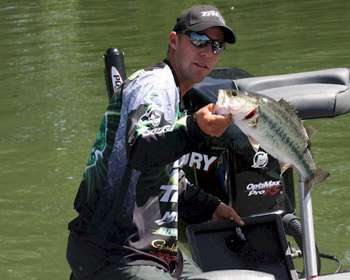
Somewhere in the bowels of his Alabama home, Elite Series pro Aaron Martens has a crankbait graveyard with an inventory greater than the average tackle shop. The inveterate tinkerer admits, "I mess up a lot of crankbaits." The downside of his constant search for better presentations is that he makes a lot of baits unusable.
The upside? Well, how do a Toyota Tundra Bassmaster Angler of the Year title and several near-misses at the Bassmaster Classic sound? The proof is in his consistency on the Elite Series trail. "I only fish a bait right out of the package about 30 percent of the time," he says. "Some of them are mild modifications, like putting a trailer hook on a spinnerbait, or changing out to Gamakatsu trebles on my crankbaits."
On the bottom of a hollow-bodied frog he'll add dots or stripes with a permanent marker. During the 2008 Elite event at Amistad, he melted together two 10-inch worms in an attempt to keep smaller fish off his line. He also takes a pair of scissors to soft plastic jerkbaits in an effort to get them to swim differently. At other times, Martens makes much more drastic changes, dramatically altering baits or possibly even melding two categories into a single lure.
For example, his Aaron Martens Lures Scrounger is a jighead with a lip or collar attached to it. At the 2004 Classic at Lake Wylie, he would have taken home the crown but for a late charge by Takahiro Omori. The key to Martens' second place finish was a homemade "horsey head" jig that resembled a forgotten panfish bait but was irresistible to the bass he found right next to the launch site. One of his most effective classes of modifications involves deep diving crankbaits, such as Mann's Deep 30+, Bomber's Fat Free Shad and Bill Norman's DD22.
"If you sand the bill to make it thinner, you can get an extra foot or so of depth and get a little more snap to it," he explains. "I have some DD22s that I can get down to 20 feet pretty easily on 10-pound fluorocarbon line. The only drawback is that the bills tend to break sooner. "I'm trying to change the action a little bit. When you have a hundred guys all throwing DD22s, the fish get so used to it, they get wary. But if you offer them something that wobbles twice as much, you'll get more bites." If you would like to try modifying your own lures, Martens recommends making changes in very small increments.
By testing each iteration in a swimming pool or a clear lake, it's possible to find the "tipping point" at which a certain bait achieves its perfect action. "Sometimes, once you get to a certain point, you can actually go beyond perfection," he explains.
"When that happens, you'll know on the next one exactly how far to go." In addition to filing crankbait bills, Martens has also experimented with efforts to weight his baits or deaden the sound. He'll drill holes in crankbait bodies and add molten lead. Or, he'll inject epoxy into the cavity to silence the rattles. Don't try those tricks unless you're willing to sacrifice a few lures.
"Sometimes those changes put them off balance," he says sheepishly. And while he admits that "sometimes just finding (the bass) is the key and tinkering doesn't pay off," Martens spends many offseason hours in his shop, searching for that perfect mousetrap. He's done it since he was 13 or 14 years old, fishing Southern California's highly pressured lakes.
Now that he's competing against the best anglers in the world, he needs a different edge to keep up his winning ways. And sometimes that edge is just a little bit sharper than it was before.
(Provided by Z3 Media)





